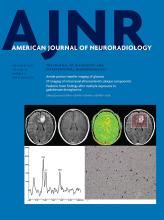Abstract
BACKGROUND AND PURPOSE: Pulsatile tinnitus is experienced by most patients with idiopathic intracranial hypertension. The pathophysiology remains uncertain; however, transverse sinus stenosis and sigmoid sinus diverticulum/dehiscence have been proposed as potential etiologies. We aimed to determine whether the prevalence of transverse sinus stenosis and sigmoid sinus diverticulum/dehiscence was increased in patients with idiopathic intracranial hypertension and pulsatile tinnitus relative to those without pulsatile tinnitus and a control group.
MATERIALS AND METHODS: CT vascular studies of patients with idiopathic intracranial hypertension with pulsatile tinnitus (n = 42), without pulsatile tinnitus (n = 37), and controls (n = 75) were independently reviewed for the presence of severe transverse sinus stenosis and sigmoid sinus diverticulum/dehiscence according to published criteria. The prevalence of transverse sinus stenosis and sigmoid sinus diverticulum/dehiscence in patients with idiopathic intracranial hypertension with pulsatile tinnitus was compared with that in the nonpulsatile tinnitus idiopathic intracranial hypertension group and the control group. Further comparisons included differing degrees of transverse sinus stenosis (50% and 75%), laterality of transverse sinus stenosis/sigmoid sinus diverticulum/dehiscence, and ipsilateral transverse sinus stenosis combined with sigmoid sinus diverticulum/dehiscence.
RESULTS: Severe bilateral transverse sinus stenoses were more frequent in patients with idiopathic intracranial hypertension than in controls (P < .001), but there was no significant association between transverse sinus stenosis and pulsatile tinnitus within the idiopathic intracranial hypertension group. Sigmoid sinus dehiscence (right- or left-sided) was also more common in patients with idiopathic intracranial hypertension compared with controls (P = .01), but there was no significant association with pulsatile tinnitus within the idiopathic intracranial hypertension group.
CONCLUSIONS: While our data corroborate previous studies demonstrating increased prevalence of sigmoid sinus diverticulum/dehiscence and transverse sinus stenosis in idiopathic intracranial hypertension, we did not establish an increased prevalence in patients with idiopathic intracranial hypertension with pulsatile tinnitus compared with those without. It is therefore unlikely that these entities represent a direct structural correlate of pulsatile tinnitus in patients with idiopathic intracranial hypertension.
ABBREVIATIONS:
- IIH
- idiopathic intracranial hypertension
- PT
- pulsatile tinnitus
- SSDD
- sigmoid sinus diverticulum/dehiscence
- TSS
- transverse sinus stenosis
- © 2017 by American Journal of Neuroradiology












